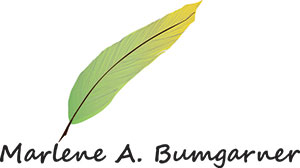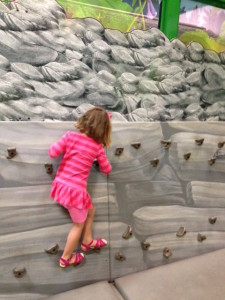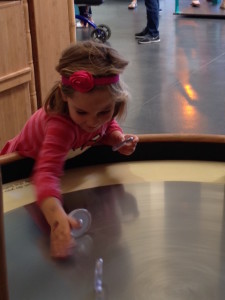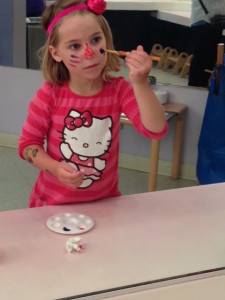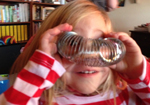Keeping Life Fun
Life can be dreary for children when one of their parents is ill. My daughter was scheduled for her third chemotherapy infusion today. Based on the way the last two treatments went, she expects to be seriously under the weather the rest of this week and probably next week too. I offered to try to keep Bean’s life as normal and fun as possible while her mama is dealing with cancer cooties, so today we embarked on our first day of Grandma Camp.
Later this week we’ll be exploring Santa Cruz, but today we drove over Highway 17 with the late commuters, and arrived at the big purple building on Woz Way just as it opened at 10:00 a.m. This was a first visit for both of us, so the first hour we just wandered aimlessly, seeing what kinds of things were there, learning how things worked, and checking out the all-important gift shop.
“Look at this, Grandma!” became the phrase of the day, as Bean ran from one interactive display to another, turning knobs, looking through peepholes, and building various constructions. The Children’s Discovery Museum, like high-touch museums in other parts of the country, is a rich and engaging environment, and if I hadn’t been having so much fun myself, I could have taken dozens of pictures of Bean losing herself in learning, something children do quite naturally (see last week’s post for my comments on that endeavor). As it is, I’ll have to settle for three glimpses of her day to share with you.
She thought the climbing wall looked interesting, but first we had to sit on the carpet across the room from it, and watch several other children navigate across. Then, well, never mind, we’re going to run across the hall to the drinking fountain and then over there to the big water tables. After exploring water pressure, air pressure, and centrifugal force in a water environment, nearly an hour later, we sidled over to the climbing wall again, determined that there was no one on it or watching it, then here we go . . .!
Learning to Learn
Something that begins to emerge during the years of early childhood is a set of skills lumped together under the term metacognition, an awareness and understanding of one’s own thought processes. Wikepedia summarizes the research on metacognition fairly well, and identifies three basic types of knowledge that can be utilized by children (and adults) as they explore new challenges.
Person knowledge
Person knowledge is also called declarative knowledge, and consists of understanding one’s own capabilities. Having this kind of understanding is an important key to a child’s self-knowledge, and eventually to his or her self esteem. One gets it from trying to do lots of things, failing at some and succeeding at others, collecting data each time, then using that data in future endeavors.
Task knowledge
Task knowledge, or procedural knowledge, involves looking at a task and analyzing its difficulty and the components involved in mastering it. This is pretty basic, but it does require observation and a certain awareness of one’s surroundings.
I think that Bean was analyzing the difficulty of the task and weighing it against her personal experiences when she was watching children on the climbing wall. She may have been summoning her courage, or simply recognizing that she needed to be unobserved when she attempted it. I’ve learned to trust her feelings when she holds back like that, and I don’t push her.
Strategic knowledge
Strategic knowledge, or conditional knowledge, allows one to use strategies to learn information or solve a complex problem. Very young children are not usually very good at this unless they have been taught to do so. Left to their own devices, preschool children and even those in early elementary school will usually try to solve problems randomly, trying first one thing, then another, and perhaps even repeating the same strategy a few times without success. Children in upper elementary have more highly developed brains, and are also more likely to have had experiences in school and/or life that lead them to organize their strategies and record the results so that they can be efficient in their problem solution.
All of these types of knowledge depend for their development on children having lots of experiences doing things. Basic physics. Jumping. Running. Climbing. Creeping. Crawling. Pouring. Piling. Stacking. Banging, Bouncing, Throwing, Catching, Dancing, Singing, etc. If that sounds like a typical preschool curriculum, it’s no accident.
Children in interactive learning and play environments such as the Children’s Discovery Museum do many of those things too. For example:
There were several activities that invited children to play with elements of physics. This one was a spinning metal circle with a hole in the middle. Metal discs were provided, and children did a variety of things with them on the spinning circle, but most of the time they just fell flat and disappeared into the hole in the middle. It was fun to crawl under the device and retrieve the discs, but some of the children (occasionally thanks to a prompt from a passing grownup or museum docent) experimented with trying to get the discs to stand up on edge. By spinning them and setting them on the disc parallel to the edge of the disc, it was possible to get them to travel all the way around the circle before they fell.
I loved watching the children trying to get the discs to stand up and not be swallowed by the hole in the middle. Failure after failure, and they still kept trying. And by the way, no parents or teachers were egging these children on. In fact, in some instances parents were coaxing the child to move on to the next exhibit, or get some lunch, or give someone else a turn. But the pull of the problem-solving process won. These children were learning to learn. And they were lost in learning. It was so very cool to watch.
We spent five hours at the Children’s Discovery Museum, and only left then because I felt the witching hour of the afternoon commute approaching. The last activity Bean chose to do was pure fun, and it was a first for her. She had looked forward to the Face Painting activity all afternoon, so imagine her surprise when she discovered there was no nice artist lady waiting to paint her face; only a pleasant docent who handed her a palette with two colors of paint, a brush, and a container of water.
Directing Bean to the large mirror and a counter for the paints, she was invited to paint her own face.
I’ll spare you the psychobabble around mirrors and stages of self awareness. This was pure fun, and a great way to end the day!
Next week: How I learned to give up whole wheat bread and love the Paleo Diet.
Share this post